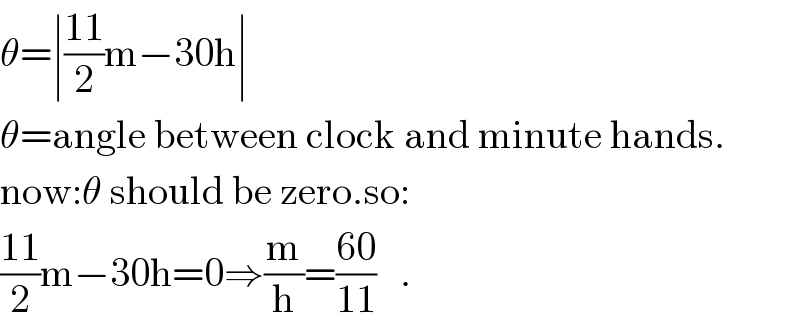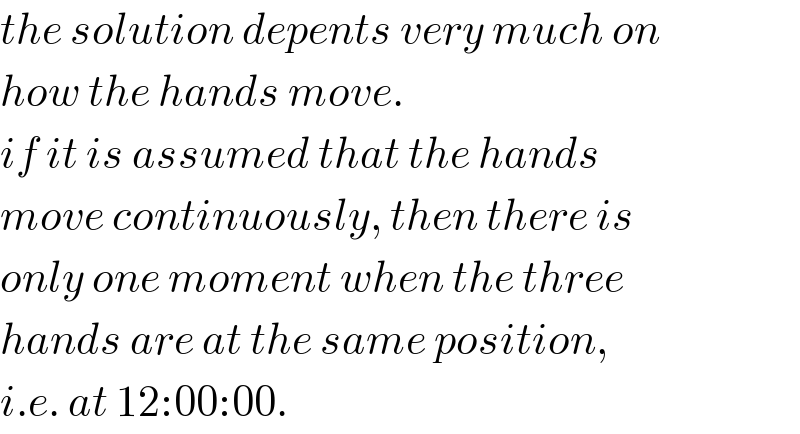
Question Number 67208 by mr W last updated on 24/Aug/19
![Find the times in a day when the hour′s, minute′s and second′s hand of a clock occupy the same angular position. [old question reposted]](Q67208.png)
$${Find}\:{the}\:{times}\:{in}\:{a}\:{day}\:{when} \\ $$$${the}\:{hour}'{s},\:{minute}'{s}\:{and}\:{second}'{s} \\ $$$${hand}\:{of}\:{a}\:{clock}\:{occupy}\:{the}\:{same} \\ $$$${angular}\:{position}. \\ $$$$\left[{old}\:{question}\:{reposted}\right] \\ $$
Commented by Kunal12588 last updated on 24/Aug/19
at 12 am and 12 pm?
Commented by mr W last updated on 24/Aug/19

$$\mathrm{12}\:{am}\:{and}\:\mathrm{12}\:{pm}\:{are}\:{certainly} \\ $$$${correct}.\:{but}\:{there}\:{are}\:{other}\:{times}. \\ $$$${observe}\:{how}\:{a}\:\left({analog},\:{mechanical}\right) \\ $$$${clock}\:{works}. \\ $$
Commented by Tinkutara@ last updated on 24/Aug/19

$$\mathrm{22}\:{times}\:{like}\:\mathrm{1}:\mathrm{05},\mathrm{2}:\mathrm{10},\mathrm{3}:\mathrm{15},\mathrm{4}:\mathrm{20},.... \\ $$$$? \\ $$
Commented by Kunal12588 last updated on 24/Aug/19

$${at}\:{those}\:{times}\:{hour}'{s}\:{hand}\:{and}\:{minute}'{s}\:{hands} \\ $$$${have}\:{same}\:{angular}\:{position}\:{but}\:{second}'{s}\:{hand} \\ $$$${has}\:{differnt}\:{angular}\:{position}.\:{isn}'{t}\:{it}. \\ $$
Commented by mr W last updated on 24/Aug/19

$${but}\:{the}\:{question}\:{means}\:{that}\:{all}\:{three} \\ $$$${hands}\:{must}\:{be}\:{at}\:{the}\:{same}\:{position}. \\ $$
Commented by behi83417@gmail.com last updated on 24/Aug/19

$$\theta=\mid\frac{\mathrm{11}}{\mathrm{2}}\mathrm{m}−\mathrm{30h}\mid \\ $$$$\theta=\mathrm{angle}\:\mathrm{between}\:\mathrm{clock}\:\mathrm{and}\:\mathrm{minute}\:\mathrm{hands}. \\ $$$$\mathrm{now}:\theta\:\mathrm{should}\:\mathrm{be}\:\mathrm{zero}.\mathrm{so}: \\ $$$$\frac{\mathrm{11}}{\mathrm{2}}\mathrm{m}−\mathrm{30h}=\mathrm{0}\Rightarrow\frac{\mathrm{m}}{\mathrm{h}}=\frac{\mathrm{60}}{\mathrm{11}}\:\:\:. \\ $$
Answered by mr W last updated on 25/Aug/19

Commented by mr W last updated on 25/Aug/19

$${this}\:{picture}\:{shows}\:{an}\:{analog}\:{clock}. \\ $$$${its}\:{hands}\:{don}'{t}\:{move}\:{continuously}, \\ $$$${but}\:{can}\:{only}\:{occupy}\:\mathrm{60}\:{possible} \\ $$$${angular}\:{positions}: \\ $$$$\mathrm{0},\mathrm{1},\mathrm{2},...,\mathrm{58},\mathrm{59} \\ $$$$ \\ $$$${the}\:{hands}\:{move}\:{in}\:{following}\:{way}: \\ $$$${the}\:{second}'{s}\:{hand}\:{moves}\:{a}\:{step} \\ $$$${every}\:{second}.\:\:{the}\:{minute}'{s}\:{hand} \\ $$$${doesn}'{t}\:{move}\:{with}\:{each}\:{move}\:{of}\: \\ $$$${the}\:{second}'{s}\:{hand}.\:{only}\:{after}\:\mathrm{60} \\ $$$${steps}\:{of}\:{the}\:{second}'{s}\:{hand}\:\left({i}.{e}.\right. \\ $$$$\left.{after}\:\mathrm{60}\:{seconds}\right)\:{the} \\ $$$${minute}'{s}\:{hand}\:{moves}\:{a}\:{step},\:{and} \\ $$$${so}\:{on}.\:{similarly}\:{the}\:{hour}'{s}\:{hand} \\ $$$${doesn}'{t}\:{move}\:{with}\:{each}\:{move}\:{of} \\ $$$${the}\:{minute}'{s}\:{hand}.\:\:{only}\:{after} \\ $$$$\mathrm{12}\:{steps}\:{of}\:{the}\:{minute}'{s}\:{hand}\:\left({i}.{e}.\right. \\ $$$$\left.{after}\:\mathrm{12}\:{minutes}\:{or}\:\mathrm{720}\:{seconds}\right) \\ $$$${the}\:{hour}'{s}\:{hand}\:{moves}\:{a}\:{step},\:{and} \\ $$$${so}\:{on}. \\ $$$$ \\ $$$${with}\:{this}\:{knowledge}\:{about}\:{how} \\ $$$${the}\:{hands}\:{of}\:{a}\:{clock}\:{work},\:{we} \\ $$$${can}\:{determine}\:{the}\:{moments}\:{when} \\ $$$${the}\:{three}\:{hands}\:{of}\:{a}\:{clock}\:{are}\:{at} \\ $$$${the}\:{same}\:{angular}\:{position}. \\ $$$${let}'{s}\:{say}\:{the}\:{time}\:{is}\:{h}\:{o}'{clock}\:{exactly}. \\ $$$$\left(\mathrm{0}\leqslant{h}\leqslant\mathrm{11}\right).\:{at}\:{this}\:{moment}\:{the} \\ $$$${hour}'{s}\:{hand}\:{is}\:{at}\:{the}\:{position}\:\mathrm{5}{h}, \\ $$$${and}\:{the}\:{minute}'{s}\:{and}\:{second}'{s} \\ $$$${hands}\:{are}\:{at}\:{position}\:\mathrm{0}.\:{after}\:{x} \\ $$$${seconds},\:{with}\:\mathrm{0}<{x}<\mathrm{3600}, \\ $$$${the}\:{position}\:{of}\:{the} \\ $$$${second}'{s}\:{hand}\:{is}\:{mod}\left({x},\mathrm{60}\right).\:{the} \\ $$$${position}\:{of}\:{the}\:{minute}'{s}\:{hand}\:{is} \\ $$$$\lfloor\frac{{x}}{\mathrm{60}}\rfloor,\:{the}\:{position}\:{of}\:{the}\:{hour}'{s} \\ $$$${is}\:\mathrm{5}{h}+\lfloor\frac{{x}}{\mathrm{720}}\rfloor.\:{such}\:{that}\:{the}\:{three} \\ $$$${hands}\:{are}\:{at}\:{the}\:{same}\:{position}: \\ $$$$\mathrm{5}{h}+\lfloor\frac{{x}}{\mathrm{720}}\rfloor=\lfloor\frac{{x}}{\mathrm{60}}\rfloor={mod}\left({x},\mathrm{60}\right) \\ $$$$ \\ $$$${we}\:{get}\:{following}\:{results}: \\ $$$${for}\:{h}=\mathrm{0}:\:{x}=\mathrm{0}\:\Rightarrow{time}\:\mathrm{0}{h}\mathrm{0}{m}\mathrm{0}{s} \\ $$$${for}\:{h}=\mathrm{1}:\:{x}=\mathrm{305}\:\Rightarrow{time}\:\mathrm{1}{h}\mathrm{5}{m}\mathrm{5}{s} \\ $$$${for}\:{h}=\mathrm{2}:\:{x}=\mathrm{610}\:\Rightarrow{time}\:\mathrm{2}{h}\mathrm{10}{m}\mathrm{10}{s} \\ $$$${for}\:{h}=\mathrm{3}:\:{x}=\mathrm{976}\:\Rightarrow{time}\:\mathrm{3}{h}\mathrm{16}{m}\mathrm{16}{s} \\ $$$${for}\:{h}=\mathrm{4}:\:{x}=\mathrm{1281}\:\Rightarrow{time}\:\mathrm{4}{h}\mathrm{21}{m}\mathrm{21}{s} \\ $$$${for}\:{h}=\mathrm{5}:\:{x}=\mathrm{1647}\:\Rightarrow{time}\:\mathrm{5}{h}\mathrm{27}{m}\mathrm{27}{s} \\ $$$${for}\:{h}=\mathrm{6}:\:{x}=\mathrm{1952}\:\Rightarrow{time}\:\mathrm{6}{h}\mathrm{32}{m}\mathrm{32}{s} \\ $$$${for}\:{h}=\mathrm{7}:\:{x}=\mathrm{2318}\:\Rightarrow{time}\:\mathrm{7}{h}\mathrm{38}{m}\mathrm{38}{s} \\ $$$${for}\:{h}=\mathrm{8}:\:{x}=\mathrm{2623}\:\Rightarrow{time}\:\mathrm{8}{h}\mathrm{43}{m}\mathrm{43}{s} \\ $$$${for}\:{h}=\mathrm{9}:\:{x}=\mathrm{2989}\:\Rightarrow{time}\:\mathrm{9}{h}\mathrm{49}{m}\mathrm{49}{s} \\ $$$${for}\:{h}=\mathrm{10}:\:{x}=\mathrm{3294}\:\Rightarrow{time}\:\mathrm{10}{h}\mathrm{54}{m}\mathrm{54}{s} \\ $$$${for}\:{h}=\mathrm{11}:\:{x}=\mathrm{3599}\:\Rightarrow{time}\:\mathrm{11}{h}\mathrm{59}{m}\mathrm{59}{s} \\ $$$${that}\:{means}\:{in}\:{a}\:{day}\:{there}\:{are}\:\mathrm{24} \\ $$$${times}\:{when}\:{the}\:{three}\:{hands}\:{of} \\ $$$${a}\:{clock}\:{are}\:{at}\:{the}\:{same}\:{angular} \\ $$$${position}. \\ $$$${the}\:{picture}\:{above}\:{shows}\:{e}.{g}.\:{the} \\ $$$${moment}\:\mathrm{4}{h}\mathrm{21}{m}\mathrm{21}{s}\:\left({am}\:{or}\:{pm}\right) \\ $$$${when}\:{the}\:{hands}\:{are}\:{at}\:{the}\:{same} \\ $$$${position}. \\ $$
Commented by JDamian last updated on 25/Aug/19

$$ \\ $$$${But}\:{many}\:{other}\:{analog}\:{clocks}\:{are}\:{not}\:{so} \\ $$$${discrete}\:−\:{second}'{s}\:{hand}\:{moves}\:{quickly}\:{than} \\ $$$${one}-{second}\:{step}\:\left({fractions}\:{of}\:{one}\:{second}\right) \\ $$
Commented by mr W last updated on 25/Aug/19

$${the}\:{solution}\:{depents}\:{very}\:{much}\:{on} \\ $$$${how}\:{the}\:{hands}\:{move}. \\ $$$${if}\:{it}\:{is}\:{assumed}\:{that}\:{the}\:{hands} \\ $$$${move}\:{continuously},\:{then}\:{there}\:{is} \\ $$$${only}\:{one}\:{moment}\:{when}\:{the}\:{three} \\ $$$${hands}\:{are}\:{at}\:{the}\:{same}\:{position}, \\ $$$${i}.{e}.\:{at}\:\mathrm{12}:\mathrm{00}:\mathrm{00}. \\ $$
